Understanding Business and Economic Environment of Unilever Report
VerifiedAdded on 2022/04/14
|10
|3047
|58
Report
AI Summary
This report provides a comprehensive analysis of Unilever's business and economic environment, focusing on its role as a manufacturing industry leader. It delves into the structure of the manufacturing industry and Unilever's position within it, examining the company's organizational structure and its alignment with global market demands. The report meticulously analyzes the external business environment through the lens of social, technological, environmental, political, legal, ethical, and economic factors over the past 5-10 years. It identifies microeconomic factors like employment, wages, and consumer confidence, as well as determinants of supply and the competitiveness of the UK market. Furthermore, it addresses the problems and challenges Unilever faces, including price maintenance and market competition, while also exploring the external effects of business decisions on customers and rivals. The report concludes with a holistic view of Unilever's operational landscape and strategic considerations.
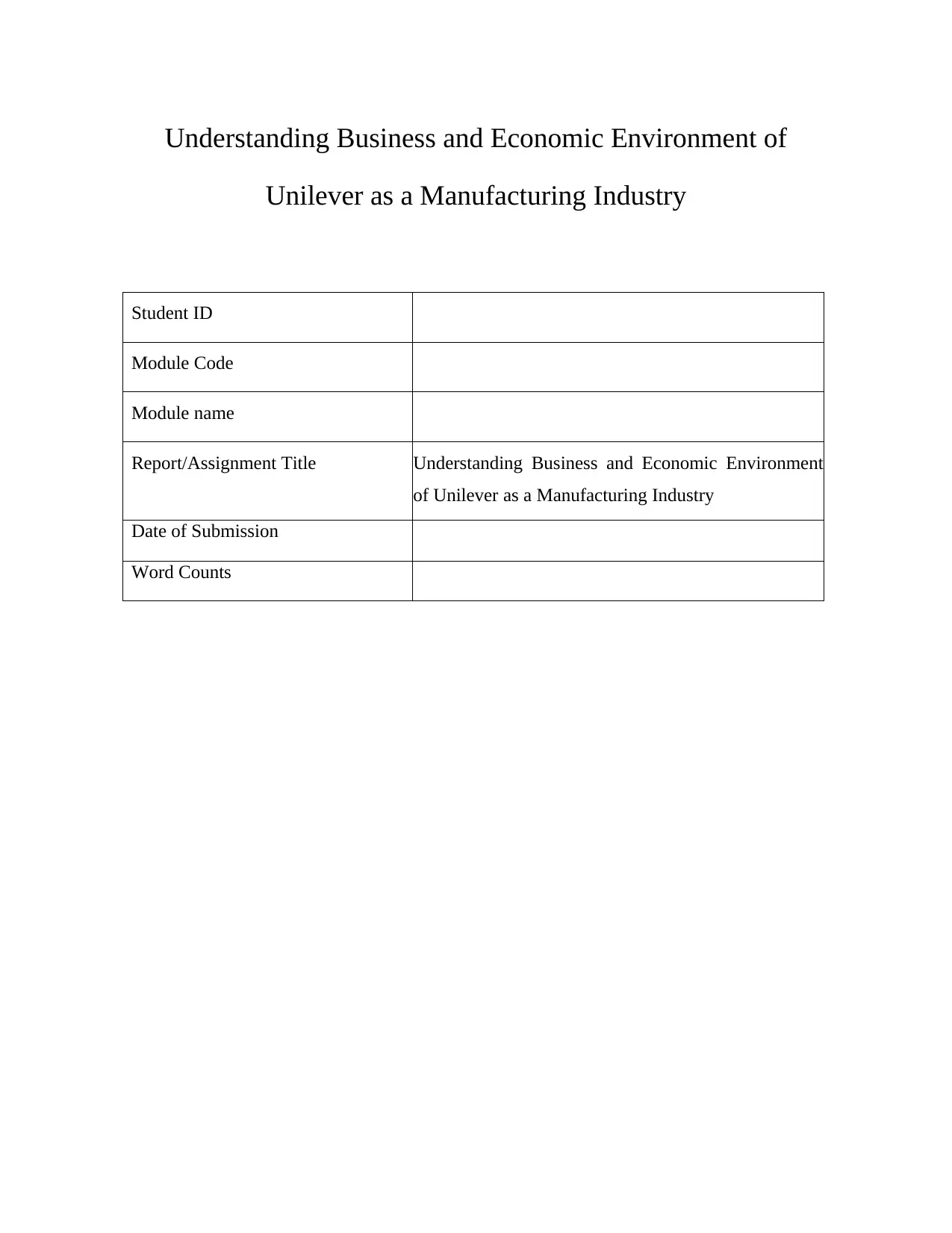
Understanding Business and Economic Environment of
Unilever as a Manufacturing Industry
Student ID
Module Code
Module name
Report/Assignment Title Understanding Business and Economic Environment
of Unilever as a Manufacturing Industry
Date of Submission
Word Counts
Unilever as a Manufacturing Industry
Student ID
Module Code
Module name
Report/Assignment Title Understanding Business and Economic Environment
of Unilever as a Manufacturing Industry
Date of Submission
Word Counts
Paraphrase This Document
Need a fresh take? Get an instant paraphrase of this document with our AI Paraphraser
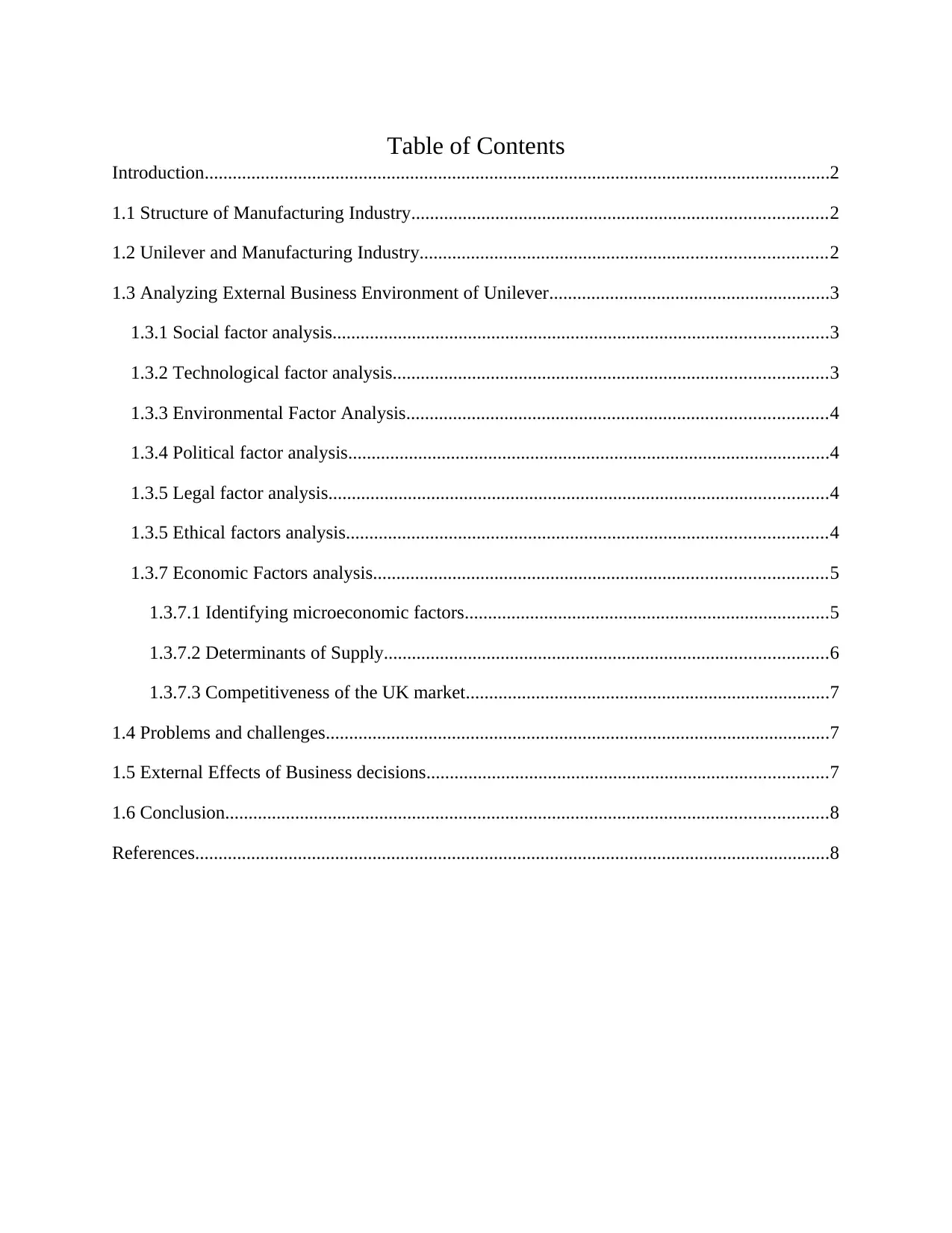
Table of Contents
Introduction......................................................................................................................................2
1.1 Structure of Manufacturing Industry.........................................................................................2
1.2 Unilever and Manufacturing Industry.......................................................................................2
1.3 Analyzing External Business Environment of Unilever............................................................3
1.3.1 Social factor analysis..........................................................................................................3
1.3.2 Technological factor analysis.............................................................................................3
1.3.3 Environmental Factor Analysis..........................................................................................4
1.3.4 Political factor analysis.......................................................................................................4
1.3.5 Legal factor analysis...........................................................................................................4
1.3.5 Ethical factors analysis.......................................................................................................4
1.3.7 Economic Factors analysis.................................................................................................5
1.3.7.1 Identifying microeconomic factors..............................................................................5
1.3.7.2 Determinants of Supply...............................................................................................6
1.3.7.3 Competitiveness of the UK market..............................................................................7
1.4 Problems and challenges............................................................................................................7
1.5 External Effects of Business decisions......................................................................................7
1.6 Conclusion.................................................................................................................................8
References........................................................................................................................................8
Introduction......................................................................................................................................2
1.1 Structure of Manufacturing Industry.........................................................................................2
1.2 Unilever and Manufacturing Industry.......................................................................................2
1.3 Analyzing External Business Environment of Unilever............................................................3
1.3.1 Social factor analysis..........................................................................................................3
1.3.2 Technological factor analysis.............................................................................................3
1.3.3 Environmental Factor Analysis..........................................................................................4
1.3.4 Political factor analysis.......................................................................................................4
1.3.5 Legal factor analysis...........................................................................................................4
1.3.5 Ethical factors analysis.......................................................................................................4
1.3.7 Economic Factors analysis.................................................................................................5
1.3.7.1 Identifying microeconomic factors..............................................................................5
1.3.7.2 Determinants of Supply...............................................................................................6
1.3.7.3 Competitiveness of the UK market..............................................................................7
1.4 Problems and challenges............................................................................................................7
1.5 External Effects of Business decisions......................................................................................7
1.6 Conclusion.................................................................................................................................8
References........................................................................................................................................8
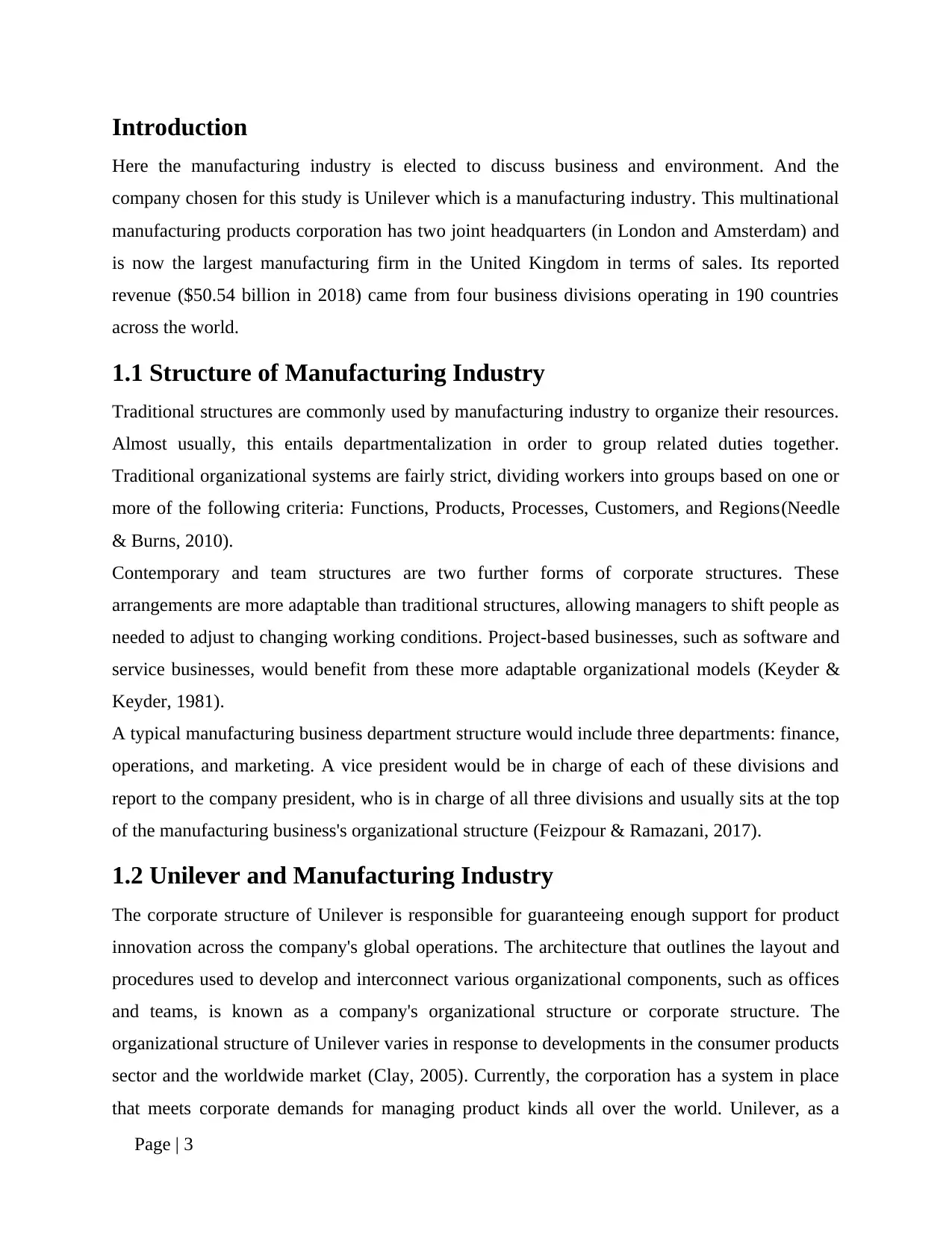
Introduction
Here the manufacturing industry is elected to discuss business and environment. And the
company chosen for this study is Unilever which is a manufacturing industry. This multinational
manufacturing products corporation has two joint headquarters (in London and Amsterdam) and
is now the largest manufacturing firm in the United Kingdom in terms of sales. Its reported
revenue ($50.54 billion in 2018) came from four business divisions operating in 190 countries
across the world.
1.1 Structure of Manufacturing Industry
Traditional structures are commonly used by manufacturing industry to organize their resources.
Almost usually, this entails departmentalization in order to group related duties together.
Traditional organizational systems are fairly strict, dividing workers into groups based on one or
more of the following criteria: Functions, Products, Processes, Customers, and Regions(Needle
& Burns, 2010).
Contemporary and team structures are two further forms of corporate structures. These
arrangements are more adaptable than traditional structures, allowing managers to shift people as
needed to adjust to changing working conditions. Project-based businesses, such as software and
service businesses, would benefit from these more adaptable organizational models (Keyder &
Keyder, 1981).
A typical manufacturing business department structure would include three departments: finance,
operations, and marketing. A vice president would be in charge of each of these divisions and
report to the company president, who is in charge of all three divisions and usually sits at the top
of the manufacturing business's organizational structure (Feizpour & Ramazani, 2017).
1.2 Unilever and Manufacturing Industry
The corporate structure of Unilever is responsible for guaranteeing enough support for product
innovation across the company's global operations. The architecture that outlines the layout and
procedures used to develop and interconnect various organizational components, such as offices
and teams, is known as a company's organizational structure or corporate structure. The
organizational structure of Unilever varies in response to developments in the consumer products
sector and the worldwide market (Clay, 2005). Currently, the corporation has a system in place
that meets corporate demands for managing product kinds all over the world. Unilever, as a
Page | 3
Here the manufacturing industry is elected to discuss business and environment. And the
company chosen for this study is Unilever which is a manufacturing industry. This multinational
manufacturing products corporation has two joint headquarters (in London and Amsterdam) and
is now the largest manufacturing firm in the United Kingdom in terms of sales. Its reported
revenue ($50.54 billion in 2018) came from four business divisions operating in 190 countries
across the world.
1.1 Structure of Manufacturing Industry
Traditional structures are commonly used by manufacturing industry to organize their resources.
Almost usually, this entails departmentalization in order to group related duties together.
Traditional organizational systems are fairly strict, dividing workers into groups based on one or
more of the following criteria: Functions, Products, Processes, Customers, and Regions(Needle
& Burns, 2010).
Contemporary and team structures are two further forms of corporate structures. These
arrangements are more adaptable than traditional structures, allowing managers to shift people as
needed to adjust to changing working conditions. Project-based businesses, such as software and
service businesses, would benefit from these more adaptable organizational models (Keyder &
Keyder, 1981).
A typical manufacturing business department structure would include three departments: finance,
operations, and marketing. A vice president would be in charge of each of these divisions and
report to the company president, who is in charge of all three divisions and usually sits at the top
of the manufacturing business's organizational structure (Feizpour & Ramazani, 2017).
1.2 Unilever and Manufacturing Industry
The corporate structure of Unilever is responsible for guaranteeing enough support for product
innovation across the company's global operations. The architecture that outlines the layout and
procedures used to develop and interconnect various organizational components, such as offices
and teams, is known as a company's organizational structure or corporate structure. The
organizational structure of Unilever varies in response to developments in the consumer products
sector and the worldwide market (Clay, 2005). Currently, the corporation has a system in place
that meets corporate demands for managing product kinds all over the world. Unilever, as a
Page | 3
⊘ This is a preview!⊘
Do you want full access?
Subscribe today to unlock all pages.

Trusted by 1+ million students worldwide
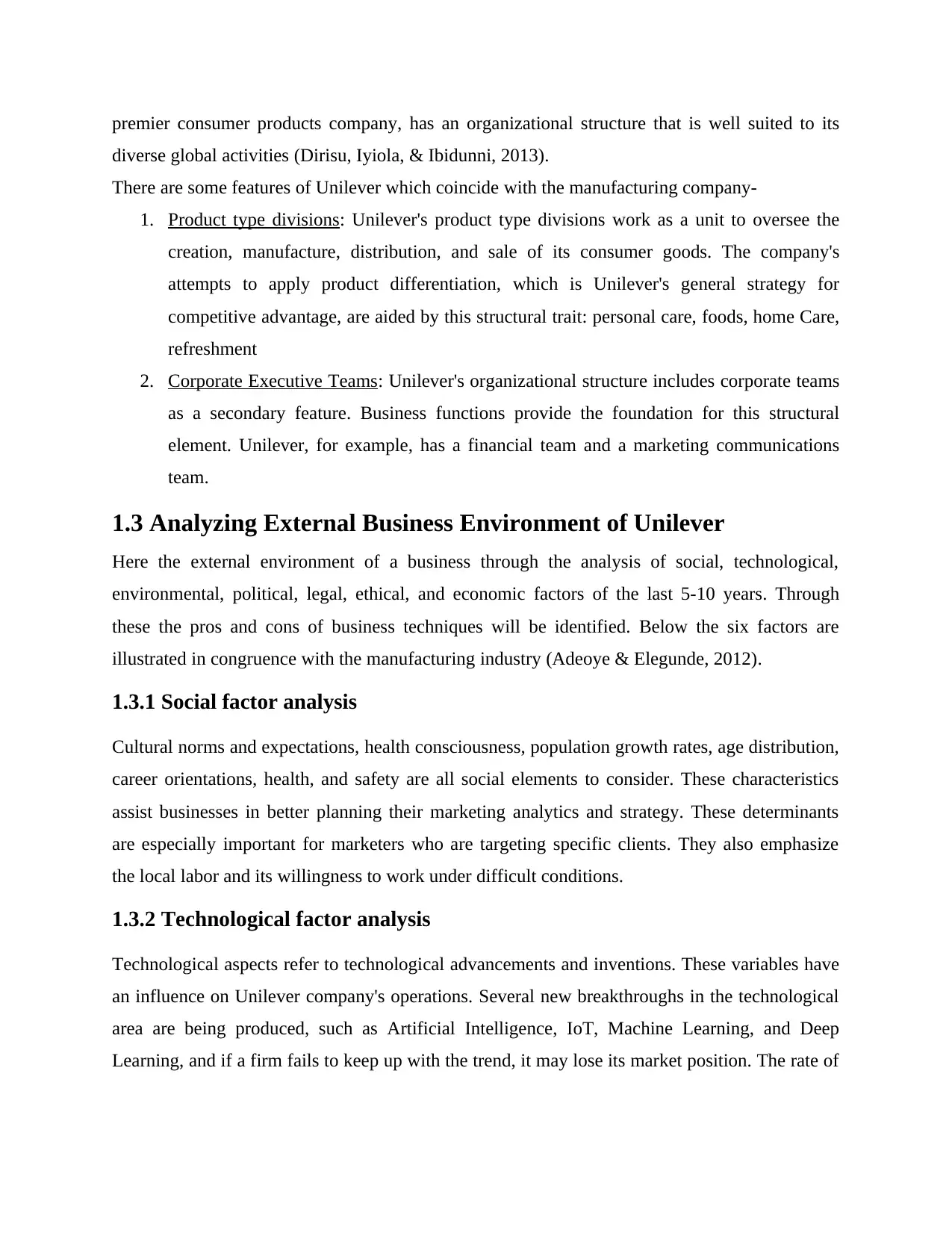
premier consumer products company, has an organizational structure that is well suited to its
diverse global activities (Dirisu, Iyiola, & Ibidunni, 2013).
There are some features of Unilever which coincide with the manufacturing company-
1. Product type divisions: Unilever's product type divisions work as a unit to oversee the
creation, manufacture, distribution, and sale of its consumer goods. The company's
attempts to apply product differentiation, which is Unilever's general strategy for
competitive advantage, are aided by this structural trait: personal care, foods, home Care,
refreshment
2. Corporate Executive Teams: Unilever's organizational structure includes corporate teams
as a secondary feature. Business functions provide the foundation for this structural
element. Unilever, for example, has a financial team and a marketing communications
team.
1.3 Analyzing External Business Environment of Unilever
Here the external environment of a business through the analysis of social, technological,
environmental, political, legal, ethical, and economic factors of the last 5-10 years. Through
these the pros and cons of business techniques will be identified. Below the six factors are
illustrated in congruence with the manufacturing industry (Adeoye & Elegunde, 2012).
1.3.1 Social factor analysis
Cultural norms and expectations, health consciousness, population growth rates, age distribution,
career orientations, health, and safety are all social elements to consider. These characteristics
assist businesses in better planning their marketing analytics and strategy. These determinants
are especially important for marketers who are targeting specific clients. They also emphasize
the local labor and its willingness to work under difficult conditions.
1.3.2 Technological factor analysis
Technological aspects refer to technological advancements and inventions. These variables have
an influence on Unilever company's operations. Several new breakthroughs in the technological
area are being produced, such as Artificial Intelligence, IoT, Machine Learning, and Deep
Learning, and if a firm fails to keep up with the trend, it may lose its market position. The rate of
diverse global activities (Dirisu, Iyiola, & Ibidunni, 2013).
There are some features of Unilever which coincide with the manufacturing company-
1. Product type divisions: Unilever's product type divisions work as a unit to oversee the
creation, manufacture, distribution, and sale of its consumer goods. The company's
attempts to apply product differentiation, which is Unilever's general strategy for
competitive advantage, are aided by this structural trait: personal care, foods, home Care,
refreshment
2. Corporate Executive Teams: Unilever's organizational structure includes corporate teams
as a secondary feature. Business functions provide the foundation for this structural
element. Unilever, for example, has a financial team and a marketing communications
team.
1.3 Analyzing External Business Environment of Unilever
Here the external environment of a business through the analysis of social, technological,
environmental, political, legal, ethical, and economic factors of the last 5-10 years. Through
these the pros and cons of business techniques will be identified. Below the six factors are
illustrated in congruence with the manufacturing industry (Adeoye & Elegunde, 2012).
1.3.1 Social factor analysis
Cultural norms and expectations, health consciousness, population growth rates, age distribution,
career orientations, health, and safety are all social elements to consider. These characteristics
assist businesses in better planning their marketing analytics and strategy. These determinants
are especially important for marketers who are targeting specific clients. They also emphasize
the local labor and its willingness to work under difficult conditions.
1.3.2 Technological factor analysis
Technological aspects refer to technological advancements and inventions. These variables have
an influence on Unilever company's operations. Several new breakthroughs in the technological
area are being produced, such as Artificial Intelligence, IoT, Machine Learning, and Deep
Learning, and if a firm fails to keep up with the trend, it may lose its market position. The rate of
Paraphrase This Document
Need a fresh take? Get an instant paraphrase of this document with our AI Paraphraser
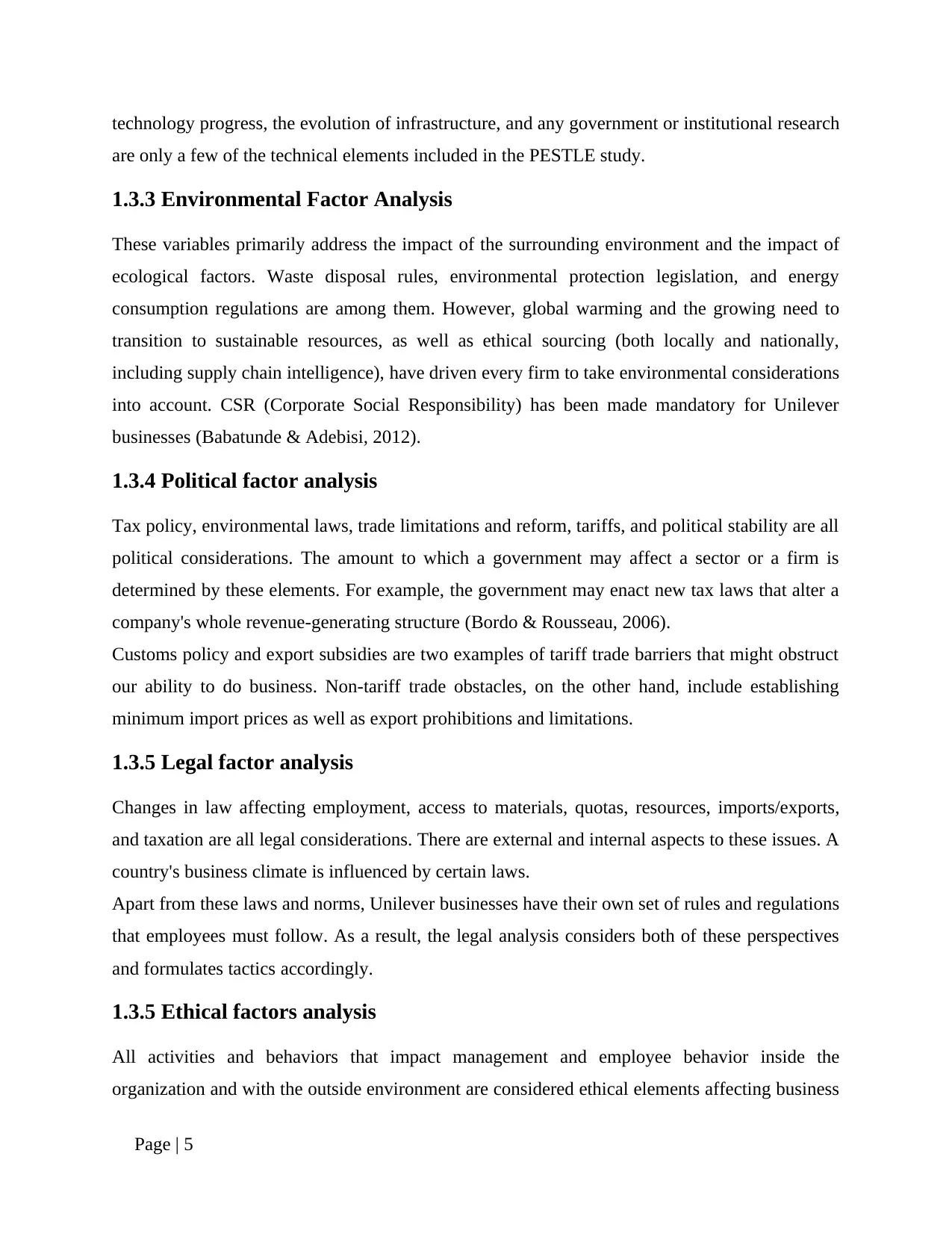
technology progress, the evolution of infrastructure, and any government or institutional research
are only a few of the technical elements included in the PESTLE study.
1.3.3 Environmental Factor Analysis
These variables primarily address the impact of the surrounding environment and the impact of
ecological factors. Waste disposal rules, environmental protection legislation, and energy
consumption regulations are among them. However, global warming and the growing need to
transition to sustainable resources, as well as ethical sourcing (both locally and nationally,
including supply chain intelligence), have driven every firm to take environmental considerations
into account. CSR (Corporate Social Responsibility) has been made mandatory for Unilever
businesses (Babatunde & Adebisi, 2012).
1.3.4 Political factor analysis
Tax policy, environmental laws, trade limitations and reform, tariffs, and political stability are all
political considerations. The amount to which a government may affect a sector or a firm is
determined by these elements. For example, the government may enact new tax laws that alter a
company's whole revenue-generating structure (Bordo & Rousseau, 2006).
Customs policy and export subsidies are two examples of tariff trade barriers that might obstruct
our ability to do business. Non-tariff trade obstacles, on the other hand, include establishing
minimum import prices as well as export prohibitions and limitations.
1.3.5 Legal factor analysis
Changes in law affecting employment, access to materials, quotas, resources, imports/exports,
and taxation are all legal considerations. There are external and internal aspects to these issues. A
country's business climate is influenced by certain laws.
Apart from these laws and norms, Unilever businesses have their own set of rules and regulations
that employees must follow. As a result, the legal analysis considers both of these perspectives
and formulates tactics accordingly.
1.3.5 Ethical factors analysis
All activities and behaviors that impact management and employee behavior inside the
organization and with the outside environment are considered ethical elements affecting business
Page | 5
are only a few of the technical elements included in the PESTLE study.
1.3.3 Environmental Factor Analysis
These variables primarily address the impact of the surrounding environment and the impact of
ecological factors. Waste disposal rules, environmental protection legislation, and energy
consumption regulations are among them. However, global warming and the growing need to
transition to sustainable resources, as well as ethical sourcing (both locally and nationally,
including supply chain intelligence), have driven every firm to take environmental considerations
into account. CSR (Corporate Social Responsibility) has been made mandatory for Unilever
businesses (Babatunde & Adebisi, 2012).
1.3.4 Political factor analysis
Tax policy, environmental laws, trade limitations and reform, tariffs, and political stability are all
political considerations. The amount to which a government may affect a sector or a firm is
determined by these elements. For example, the government may enact new tax laws that alter a
company's whole revenue-generating structure (Bordo & Rousseau, 2006).
Customs policy and export subsidies are two examples of tariff trade barriers that might obstruct
our ability to do business. Non-tariff trade obstacles, on the other hand, include establishing
minimum import prices as well as export prohibitions and limitations.
1.3.5 Legal factor analysis
Changes in law affecting employment, access to materials, quotas, resources, imports/exports,
and taxation are all legal considerations. There are external and internal aspects to these issues. A
country's business climate is influenced by certain laws.
Apart from these laws and norms, Unilever businesses have their own set of rules and regulations
that employees must follow. As a result, the legal analysis considers both of these perspectives
and formulates tactics accordingly.
1.3.5 Ethical factors analysis
All activities and behaviors that impact management and employee behavior inside the
organization and with the outside environment are considered ethical elements affecting business
Page | 5
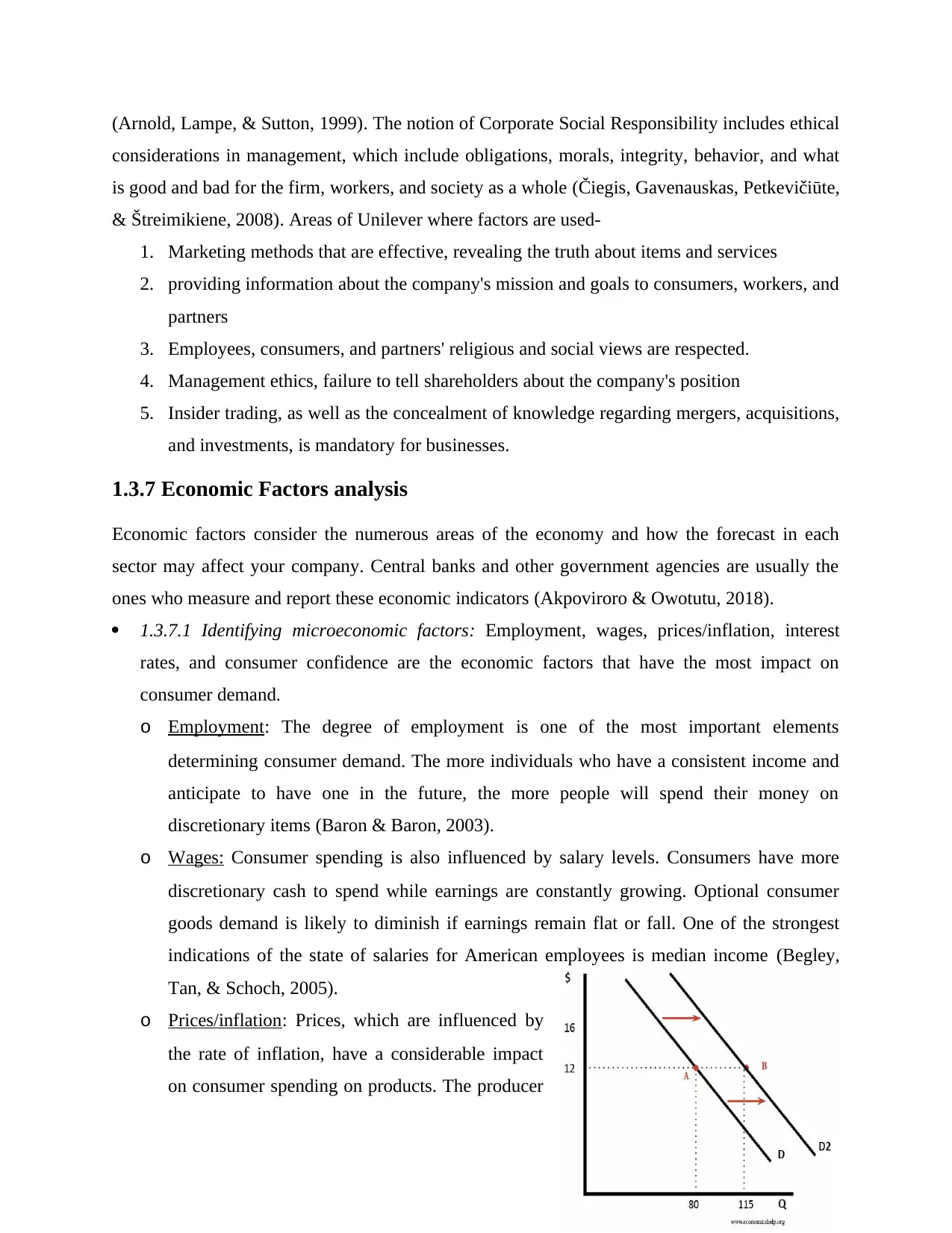
(Arnold, Lampe, & Sutton, 1999). The notion of Corporate Social Responsibility includes ethical
considerations in management, which include obligations, morals, integrity, behavior, and what
is good and bad for the firm, workers, and society as a whole (Čiegis, Gavenauskas, Petkevičiūte,
& Štreimikiene, 2008). Areas of Unilever where factors are used-
1. Marketing methods that are effective, revealing the truth about items and services
2. providing information about the company's mission and goals to consumers, workers, and
partners
3. Employees, consumers, and partners' religious and social views are respected.
4. Management ethics, failure to tell shareholders about the company's position
5. Insider trading, as well as the concealment of knowledge regarding mergers, acquisitions,
and investments, is mandatory for businesses.
1.3.7 Economic Factors analysis
Economic factors consider the numerous areas of the economy and how the forecast in each
sector may affect your company. Central banks and other government agencies are usually the
ones who measure and report these economic indicators (Akpoviroro & Owotutu, 2018).
1.3.7.1 Identifying microeconomic factors: Employment, wages, prices/inflation, interest
rates, and consumer confidence are the economic factors that have the most impact on
consumer demand.
o Employment: The degree of employment is one of the most important elements
determining consumer demand. The more individuals who have a consistent income and
anticipate to have one in the future, the more people will spend their money on
discretionary items (Baron & Baron, 2003).
o Wages: Consumer spending is also influenced by salary levels. Consumers have more
discretionary cash to spend while earnings are constantly growing. Optional consumer
goods demand is likely to diminish if earnings remain flat or fall. One of the strongest
indications of the state of salaries for American employees is median income (Begley,
Tan, & Schoch, 2005).
o Prices/inflation: Prices, which are influenced by
the rate of inflation, have a considerable impact
on consumer spending on products. The producer
considerations in management, which include obligations, morals, integrity, behavior, and what
is good and bad for the firm, workers, and society as a whole (Čiegis, Gavenauskas, Petkevičiūte,
& Štreimikiene, 2008). Areas of Unilever where factors are used-
1. Marketing methods that are effective, revealing the truth about items and services
2. providing information about the company's mission and goals to consumers, workers, and
partners
3. Employees, consumers, and partners' religious and social views are respected.
4. Management ethics, failure to tell shareholders about the company's position
5. Insider trading, as well as the concealment of knowledge regarding mergers, acquisitions,
and investments, is mandatory for businesses.
1.3.7 Economic Factors analysis
Economic factors consider the numerous areas of the economy and how the forecast in each
sector may affect your company. Central banks and other government agencies are usually the
ones who measure and report these economic indicators (Akpoviroro & Owotutu, 2018).
1.3.7.1 Identifying microeconomic factors: Employment, wages, prices/inflation, interest
rates, and consumer confidence are the economic factors that have the most impact on
consumer demand.
o Employment: The degree of employment is one of the most important elements
determining consumer demand. The more individuals who have a consistent income and
anticipate to have one in the future, the more people will spend their money on
discretionary items (Baron & Baron, 2003).
o Wages: Consumer spending is also influenced by salary levels. Consumers have more
discretionary cash to spend while earnings are constantly growing. Optional consumer
goods demand is likely to diminish if earnings remain flat or fall. One of the strongest
indications of the state of salaries for American employees is median income (Begley,
Tan, & Schoch, 2005).
o Prices/inflation: Prices, which are influenced by
the rate of inflation, have a considerable impact
on consumer spending on products. The producer
⊘ This is a preview!⊘
Do you want full access?
Subscribe today to unlock all pages.

Trusted by 1+ million students worldwide
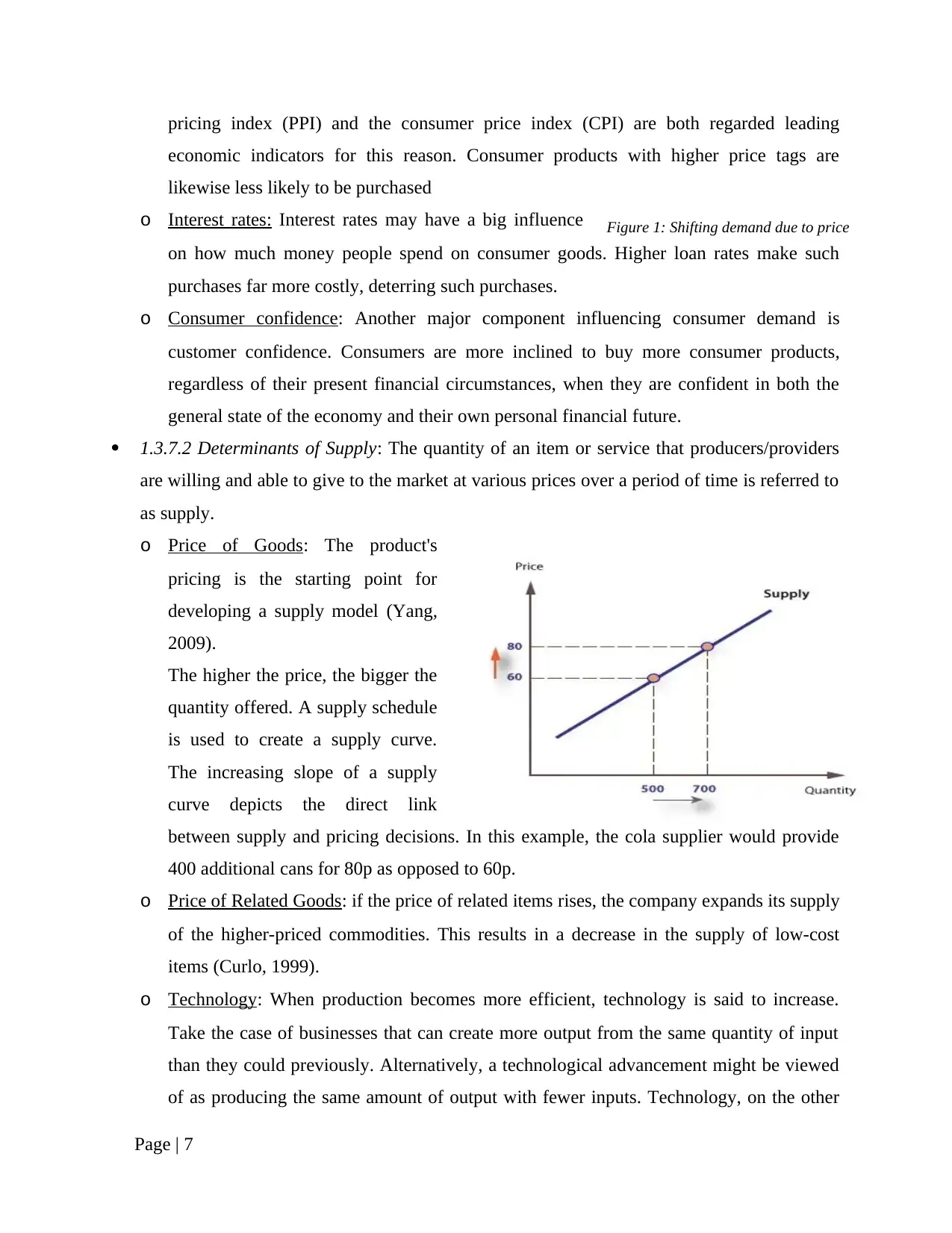
pricing index (PPI) and the consumer price index (CPI) are both regarded leading
economic indicators for this reason. Consumer products with higher price tags are
likewise less likely to be purchased
o Interest rates: Interest rates may have a big influence
on how much money people spend on consumer goods. Higher loan rates make such
purchases far more costly, deterring such purchases.
o Consumer confidence: Another major component influencing consumer demand is
customer confidence. Consumers are more inclined to buy more consumer products,
regardless of their present financial circumstances, when they are confident in both the
general state of the economy and their own personal financial future.
1.3.7.2 Determinants of Supply: The quantity of an item or service that producers/providers
are willing and able to give to the market at various prices over a period of time is referred to
as supply.
o Price of Goods: The product's
pricing is the starting point for
developing a supply model (Yang,
2009).
The higher the price, the bigger the
quantity offered. A supply schedule
is used to create a supply curve.
The increasing slope of a supply
curve depicts the direct link
between supply and pricing decisions. In this example, the cola supplier would provide
400 additional cans for 80p as opposed to 60p.
o Price of Related Goods: if the price of related items rises, the company expands its supply
of the higher-priced commodities. This results in a decrease in the supply of low-cost
items (Curlo, 1999).
o Technology: When production becomes more efficient, technology is said to increase.
Take the case of businesses that can create more output from the same quantity of input
than they could previously. Alternatively, a technological advancement might be viewed
of as producing the same amount of output with fewer inputs. Technology, on the other
Page | 7
Figure 1: Shifting demand due to price
economic indicators for this reason. Consumer products with higher price tags are
likewise less likely to be purchased
o Interest rates: Interest rates may have a big influence
on how much money people spend on consumer goods. Higher loan rates make such
purchases far more costly, deterring such purchases.
o Consumer confidence: Another major component influencing consumer demand is
customer confidence. Consumers are more inclined to buy more consumer products,
regardless of their present financial circumstances, when they are confident in both the
general state of the economy and their own personal financial future.
1.3.7.2 Determinants of Supply: The quantity of an item or service that producers/providers
are willing and able to give to the market at various prices over a period of time is referred to
as supply.
o Price of Goods: The product's
pricing is the starting point for
developing a supply model (Yang,
2009).
The higher the price, the bigger the
quantity offered. A supply schedule
is used to create a supply curve.
The increasing slope of a supply
curve depicts the direct link
between supply and pricing decisions. In this example, the cola supplier would provide
400 additional cans for 80p as opposed to 60p.
o Price of Related Goods: if the price of related items rises, the company expands its supply
of the higher-priced commodities. This results in a decrease in the supply of low-cost
items (Curlo, 1999).
o Technology: When production becomes more efficient, technology is said to increase.
Take the case of businesses that can create more output from the same quantity of input
than they could previously. Alternatively, a technological advancement might be viewed
of as producing the same amount of output with fewer inputs. Technology, on the other
Page | 7
Figure 1: Shifting demand due to price
Paraphrase This Document
Need a fresh take? Get an instant paraphrase of this document with our AI Paraphraser
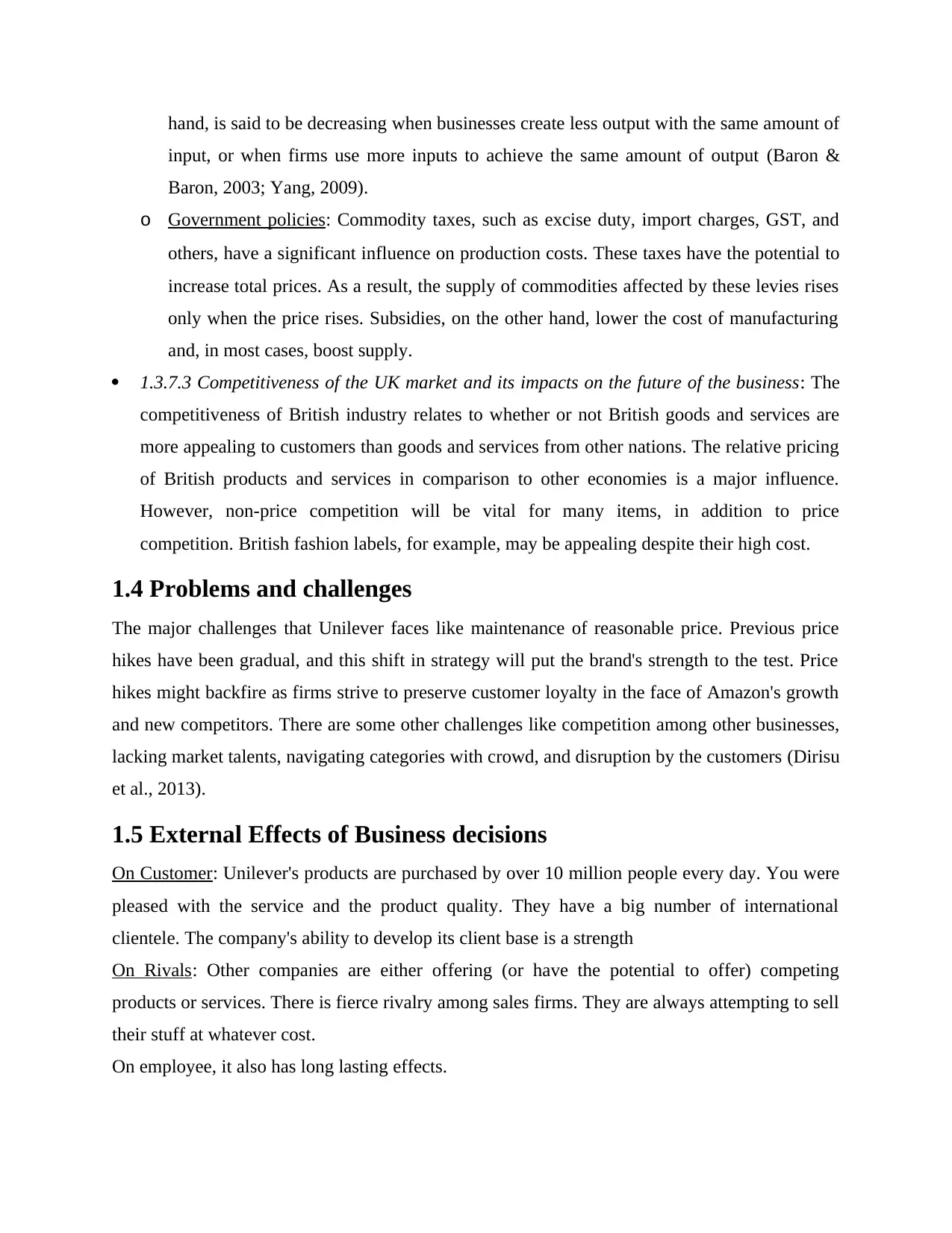
hand, is said to be decreasing when businesses create less output with the same amount of
input, or when firms use more inputs to achieve the same amount of output (Baron &
Baron, 2003; Yang, 2009).
o Government policies: Commodity taxes, such as excise duty, import charges, GST, and
others, have a significant influence on production costs. These taxes have the potential to
increase total prices. As a result, the supply of commodities affected by these levies rises
only when the price rises. Subsidies, on the other hand, lower the cost of manufacturing
and, in most cases, boost supply.
1.3.7.3 Competitiveness of the UK market and its impacts on the future of the business: The
competitiveness of British industry relates to whether or not British goods and services are
more appealing to customers than goods and services from other nations. The relative pricing
of British products and services in comparison to other economies is a major influence.
However, non-price competition will be vital for many items, in addition to price
competition. British fashion labels, for example, may be appealing despite their high cost.
1.4 Problems and challenges
The major challenges that Unilever faces like maintenance of reasonable price. Previous price
hikes have been gradual, and this shift in strategy will put the brand's strength to the test. Price
hikes might backfire as firms strive to preserve customer loyalty in the face of Amazon's growth
and new competitors. There are some other challenges like competition among other businesses,
lacking market talents, navigating categories with crowd, and disruption by the customers (Dirisu
et al., 2013).
1.5 External Effects of Business decisions
On Customer: Unilever's products are purchased by over 10 million people every day. You were
pleased with the service and the product quality. They have a big number of international
clientele. The company's ability to develop its client base is a strength
On Rivals: Other companies are either offering (or have the potential to offer) competing
products or services. There is fierce rivalry among sales firms. They are always attempting to sell
their stuff at whatever cost.
On employee, it also has long lasting effects.
input, or when firms use more inputs to achieve the same amount of output (Baron &
Baron, 2003; Yang, 2009).
o Government policies: Commodity taxes, such as excise duty, import charges, GST, and
others, have a significant influence on production costs. These taxes have the potential to
increase total prices. As a result, the supply of commodities affected by these levies rises
only when the price rises. Subsidies, on the other hand, lower the cost of manufacturing
and, in most cases, boost supply.
1.3.7.3 Competitiveness of the UK market and its impacts on the future of the business: The
competitiveness of British industry relates to whether or not British goods and services are
more appealing to customers than goods and services from other nations. The relative pricing
of British products and services in comparison to other economies is a major influence.
However, non-price competition will be vital for many items, in addition to price
competition. British fashion labels, for example, may be appealing despite their high cost.
1.4 Problems and challenges
The major challenges that Unilever faces like maintenance of reasonable price. Previous price
hikes have been gradual, and this shift in strategy will put the brand's strength to the test. Price
hikes might backfire as firms strive to preserve customer loyalty in the face of Amazon's growth
and new competitors. There are some other challenges like competition among other businesses,
lacking market talents, navigating categories with crowd, and disruption by the customers (Dirisu
et al., 2013).
1.5 External Effects of Business decisions
On Customer: Unilever's products are purchased by over 10 million people every day. You were
pleased with the service and the product quality. They have a big number of international
clientele. The company's ability to develop its client base is a strength
On Rivals: Other companies are either offering (or have the potential to offer) competing
products or services. There is fierce rivalry among sales firms. They are always attempting to sell
their stuff at whatever cost.
On employee, it also has long lasting effects.
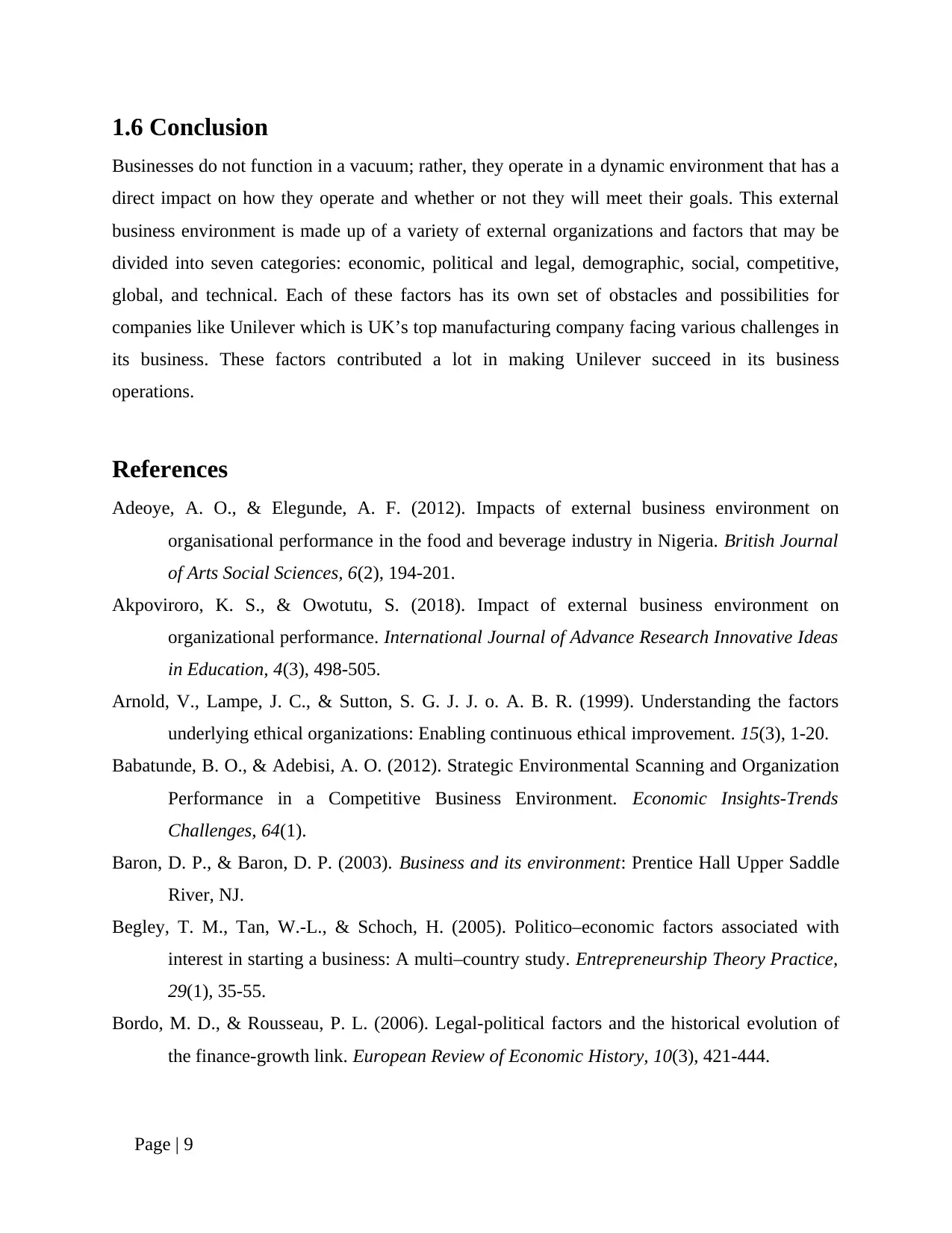
1.6 Conclusion
Businesses do not function in a vacuum; rather, they operate in a dynamic environment that has a
direct impact on how they operate and whether or not they will meet their goals. This external
business environment is made up of a variety of external organizations and factors that may be
divided into seven categories: economic, political and legal, demographic, social, competitive,
global, and technical. Each of these factors has its own set of obstacles and possibilities for
companies like Unilever which is UK’s top manufacturing company facing various challenges in
its business. These factors contributed a lot in making Unilever succeed in its business
operations.
References
Adeoye, A. O., & Elegunde, A. F. (2012). Impacts of external business environment on
organisational performance in the food and beverage industry in Nigeria. British Journal
of Arts Social Sciences, 6(2), 194-201.
Akpoviroro, K. S., & Owotutu, S. (2018). Impact of external business environment on
organizational performance. International Journal of Advance Research Innovative Ideas
in Education, 4(3), 498-505.
Arnold, V., Lampe, J. C., & Sutton, S. G. J. J. o. A. B. R. (1999). Understanding the factors
underlying ethical organizations: Enabling continuous ethical improvement. 15(3), 1-20.
Babatunde, B. O., & Adebisi, A. O. (2012). Strategic Environmental Scanning and Organization
Performance in a Competitive Business Environment. Economic Insights-Trends
Challenges, 64(1).
Baron, D. P., & Baron, D. P. (2003). Business and its environment: Prentice Hall Upper Saddle
River, NJ.
Begley, T. M., Tan, W.-L., & Schoch, H. (2005). Politico–economic factors associated with
interest in starting a business: A multi–country study. Entrepreneurship Theory Practice,
29(1), 35-55.
Bordo, M. D., & Rousseau, P. L. (2006). Legal-political factors and the historical evolution of
the finance-growth link. European Review of Economic History, 10(3), 421-444.
Page | 9
Businesses do not function in a vacuum; rather, they operate in a dynamic environment that has a
direct impact on how they operate and whether or not they will meet their goals. This external
business environment is made up of a variety of external organizations and factors that may be
divided into seven categories: economic, political and legal, demographic, social, competitive,
global, and technical. Each of these factors has its own set of obstacles and possibilities for
companies like Unilever which is UK’s top manufacturing company facing various challenges in
its business. These factors contributed a lot in making Unilever succeed in its business
operations.
References
Adeoye, A. O., & Elegunde, A. F. (2012). Impacts of external business environment on
organisational performance in the food and beverage industry in Nigeria. British Journal
of Arts Social Sciences, 6(2), 194-201.
Akpoviroro, K. S., & Owotutu, S. (2018). Impact of external business environment on
organizational performance. International Journal of Advance Research Innovative Ideas
in Education, 4(3), 498-505.
Arnold, V., Lampe, J. C., & Sutton, S. G. J. J. o. A. B. R. (1999). Understanding the factors
underlying ethical organizations: Enabling continuous ethical improvement. 15(3), 1-20.
Babatunde, B. O., & Adebisi, A. O. (2012). Strategic Environmental Scanning and Organization
Performance in a Competitive Business Environment. Economic Insights-Trends
Challenges, 64(1).
Baron, D. P., & Baron, D. P. (2003). Business and its environment: Prentice Hall Upper Saddle
River, NJ.
Begley, T. M., Tan, W.-L., & Schoch, H. (2005). Politico–economic factors associated with
interest in starting a business: A multi–country study. Entrepreneurship Theory Practice,
29(1), 35-55.
Bordo, M. D., & Rousseau, P. L. (2006). Legal-political factors and the historical evolution of
the finance-growth link. European Review of Economic History, 10(3), 421-444.
Page | 9
⊘ This is a preview!⊘
Do you want full access?
Subscribe today to unlock all pages.

Trusted by 1+ million students worldwide
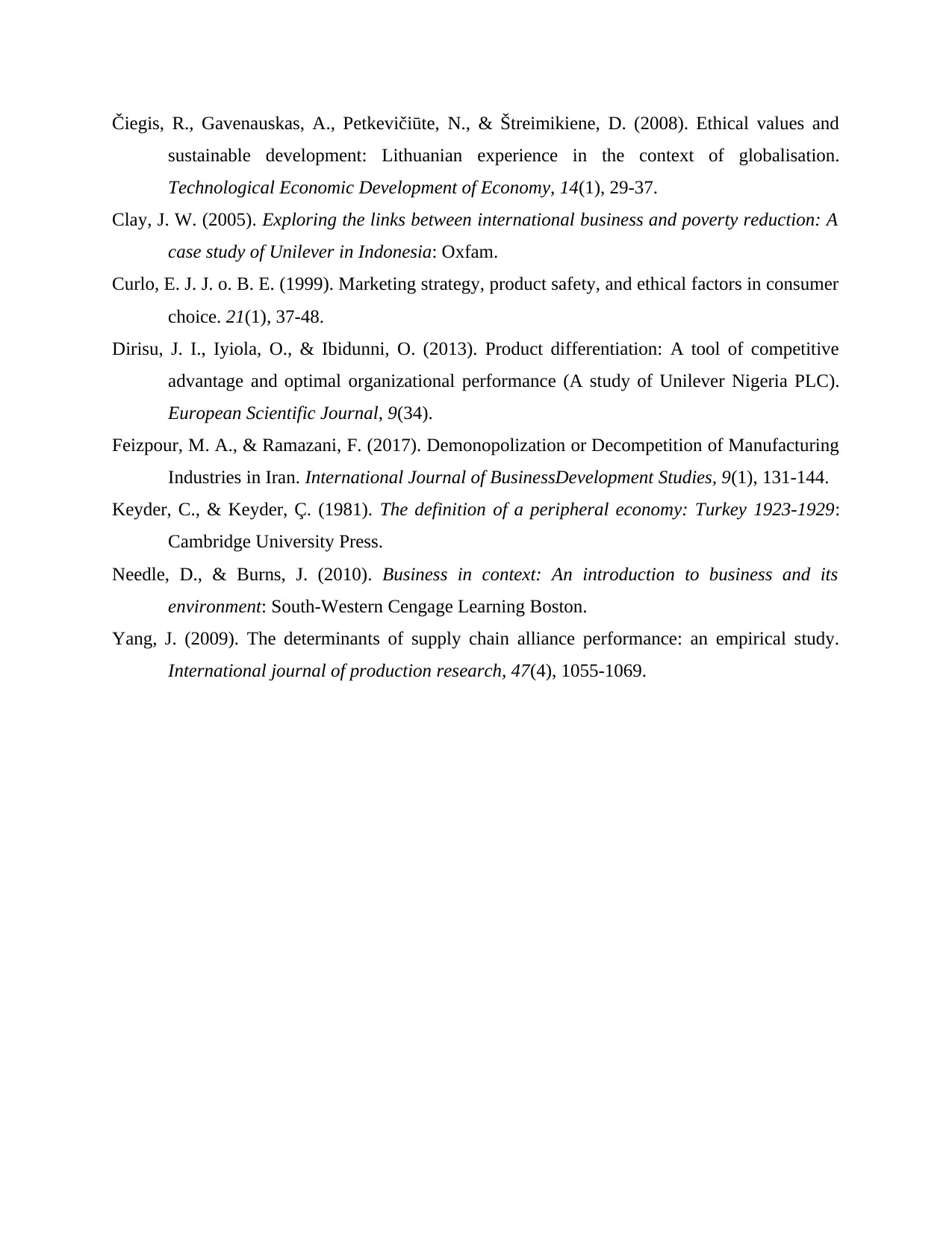
Čiegis, R., Gavenauskas, A., Petkevičiūte, N., & Štreimikiene, D. (2008). Ethical values and
sustainable development: Lithuanian experience in the context of globalisation.
Technological Economic Development of Economy, 14(1), 29-37.
Clay, J. W. (2005). Exploring the links between international business and poverty reduction: A
case study of Unilever in Indonesia: Oxfam.
Curlo, E. J. J. o. B. E. (1999). Marketing strategy, product safety, and ethical factors in consumer
choice. 21(1), 37-48.
Dirisu, J. I., Iyiola, O., & Ibidunni, O. (2013). Product differentiation: A tool of competitive
advantage and optimal organizational performance (A study of Unilever Nigeria PLC).
European Scientific Journal, 9(34).
Feizpour, M. A., & Ramazani, F. (2017). Demonopolization or Decompetition of Manufacturing
Industries in Iran. International Journal of BusinessDevelopment Studies, 9(1), 131-144.
Keyder, C., & Keyder, Ç. (1981). The definition of a peripheral economy: Turkey 1923-1929:
Cambridge University Press.
Needle, D., & Burns, J. (2010). Business in context: An introduction to business and its
environment: South-Western Cengage Learning Boston.
Yang, J. (2009). The determinants of supply chain alliance performance: an empirical study.
International journal of production research, 47(4), 1055-1069.
sustainable development: Lithuanian experience in the context of globalisation.
Technological Economic Development of Economy, 14(1), 29-37.
Clay, J. W. (2005). Exploring the links between international business and poverty reduction: A
case study of Unilever in Indonesia: Oxfam.
Curlo, E. J. J. o. B. E. (1999). Marketing strategy, product safety, and ethical factors in consumer
choice. 21(1), 37-48.
Dirisu, J. I., Iyiola, O., & Ibidunni, O. (2013). Product differentiation: A tool of competitive
advantage and optimal organizational performance (A study of Unilever Nigeria PLC).
European Scientific Journal, 9(34).
Feizpour, M. A., & Ramazani, F. (2017). Demonopolization or Decompetition of Manufacturing
Industries in Iran. International Journal of BusinessDevelopment Studies, 9(1), 131-144.
Keyder, C., & Keyder, Ç. (1981). The definition of a peripheral economy: Turkey 1923-1929:
Cambridge University Press.
Needle, D., & Burns, J. (2010). Business in context: An introduction to business and its
environment: South-Western Cengage Learning Boston.
Yang, J. (2009). The determinants of supply chain alliance performance: an empirical study.
International journal of production research, 47(4), 1055-1069.
1 out of 10
Related Documents
Your All-in-One AI-Powered Toolkit for Academic Success.
+13062052269
info@desklib.com
Available 24*7 on WhatsApp / Email
![[object Object]](/_next/static/media/star-bottom.7253800d.svg)
Unlock your academic potential
Copyright © 2020–2025 A2Z Services. All Rights Reserved. Developed and managed by ZUCOL.



